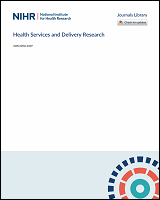NCBI Bookshelf. A service of the National Library of Medicine, National Institutes of Health.
Fisher RJ, Chouliara N, Byrne A, et al. Large-scale implementation of stroke early supported discharge: the WISE realist mixed-methods study. Southampton (UK): NIHR Journals Library; 2021 Nov. (Health Services and Delivery Research, No. 9.22.)

Large-scale implementation of stroke early supported discharge: the WISE realist mixed-methods study.
Show detailsIntroduction
Findings from WP1 (see Chapter 4) suggested that a range of ESD models had been adopted. In WP2, our aim was to gain a deeper understanding of the types of model in operation. Using a purposive sampling approach, case study sites from WP1 were selected based on the level to which evidence-based ESD was implemented (contrasting ESD models) and the influence of rurality on ESD effectiveness (urban vs. rural sites). To create service descriptions of each ESD model in operation, we collected documentary evidence from the six purposively selected sites. We also collected data about staffing and adopted models of care from each team leader using a questionnaire (also used in Chapter 7). These data were complemented and validated by qualitative data collected in ESD team interviews (details in Chapter 8).
This chapter provides a brief overview of the six services that participated in our WP2 fieldwork research.
More detailed information about each individual service is provided in Appendix 3. Service descriptions are based on data collected during WP2, information gathered at meetings with services during site visits, documentary material and interviews with staff and commissioners within the data collection process.
Site summary
The sites were labelled A–F, with site A being the most urban through to site F being the most rural. Sites A and B were clearly distinguished as hybrid services providing both an ESD service and a community rehabilitation service. The more rural services were not providing a clearly defined hybrid service but they did offer additional time and service to their patients based on need beyond the level of a strict ESD service.
The individual service descriptions in Appendix 3 highlight variation in the way that services had been developed and configured to meet the needs of the local stroke pathways and geography. Some had been established for a much longer period of time than others, and had gradually adapted over time to meet the changing needs of their population and wider health services.
Models of operation were tailored to each service, with some teams taking referrals widely, including from GPs and by self-referral, whereas other teams adhered rigidly to acute trust referrals only. Some teams in-reached to the acute trusts and others did not. Eligibility criteria also varied depending on the way that services were configured and again were related to the wider stroke pathway, capacity and resources (Table 15) in the team, and the availability of other services to take patients with more severe disability. Patient length of stay varied from the recommended average of 6 weeks to 20 weeks.
TABLE 15
Multidisciplinary team composition by WTE units (2018–19)
There were some commonalities between the teams, including stated responsiveness times driven by national SSNAP targets. Systems, processes and ways of working were configured to ensure that patients were seen within 24 hours and had a therapy assessment within 72 hours of admission to the team, although mechanisms for achieving these targets varied widely. All teams held weekly MDT meetings and routinely collected data for audit and evaluation purposes over and above the nationally mandated SSNAP data set.
Team compositions
Table 15 displays the MDT compositions for the six sites in terms of WTE units for all of the main job types and grades. Only two services had a stated manager as part of the team and the most rural service in this study was operating without administrative support or a manager at the time of our data collection. The total WTE units for each service appear to increase as the patient caseload increases, but on closer inspection the two stated hybrid services see approximately double the number of patients per WTE unit than the ESD-only services. It is important to note that the hybrid services in this study operate in the most urban areas, therefore, are dealing with more densely populated areas than the more rural ESD-only services in this study.
As can be seen from Table 15, the variation in the models is considerable and has consequences for the effectiveness of the team and monetary costs associated with providing the service. These costs and consequences are explored and discussed in greater detail in Chapter 7.
- Work package 2: service descriptions - Large-scale implementation of stroke earl...Work package 2: service descriptions - Large-scale implementation of stroke early supported discharge: the WISE realist mixed-methods study
- Pero amanda cytochrome oxidase subunit 1 (COI) gene, partial cds; mitochondrialPero amanda cytochrome oxidase subunit 1 (COI) gene, partial cds; mitochondrialgi|374964773|gnl|uoguelph|BLPCD009- I-5P|gb|JQ559978.1|Nucleotide
- phosphoserine phosphatase [Homo sapiens]phosphoserine phosphatase [Homo sapiens]gi|1635577223|ref|NP_001357434.1|Protein
- chalcone synthase, partial [Cardamine maritima]chalcone synthase, partial [Cardamine maritima]gi|215513680|gb|ACJ68497.1|Protein
- CBSS4057.rev NICHD_XGC_tropSp1 Xenopus tropicalis cDNA clone IMAGE:8896210 3', m...CBSS4057.rev NICHD_XGC_tropSp1 Xenopus tropicalis cDNA clone IMAGE:8896210 3', mRNA sequencegi|126605989|gnl|dbEST|45115569|gb| 210.1|Nucleotide
Your browsing activity is empty.
Activity recording is turned off.
See more...